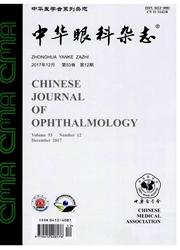

 中文摘要:
中文摘要:
目的探讨人角膜碱烧伤后新生淋巴管的生长情况及其影响因素。方法回顾性系列病例研究。分析2005年1至12月期间在中山大学中山眼科中心因角膜碱烧伤住院手术治疗的22例(22只眼)患者。记录患眼的烧伤时间(IT)和损伤等级(ID),并测量炎性反应指数(II)和角膜新生血管的相对面积(BVA);应用双重酶组织化学、免疫组织化学染色及透射电镜检测角膜标本的新生淋巴管(LVC)和血管(BVC);采用苏木素一伊红染色检测多形核白细胞(PMN)浸润情况。结果采用配对Studentt检验、Pearson相关检验及Stepwise回归进行统计学分析。结果22例患者观测结果IT为(57.62±31.72)个月、ID为(12.00±2.76)分、II为(2.32±2.63)分、BVA为29.79%±18.61%、BVC为(14.45±9.29)个、LVC为(2.73±4.57)个、PMN为(13.45±13.09)个,其中7例(占32%,IT〈64个月)同时存在角膜新生淋巴管(8.6±3.8)个和血管(22.3±11.1)个,LVC总数为60个,占发生新生淋巴管的角膜中总管腔数(BVC和LVC,378个)的16%。LVC与TT、ID、BVA、PMN、II的相关系数分别为-0.673、0.604、0.755、0.806、0.873,均P〈0.05;进一步回顾分析得出LVC近似等于II和BVA分别和特定的常数相乘后取和所得的淋巴管指数(LI)。透射电镜从微观上证实了碱烧伤人角膜组织中存在具有典型结构特征的新生淋巴管和炎性细胞浸润。结论碱烧伤后部分角膜组织存在新生淋巴管,通过II和BVA可间接估计其发生情况。LI是一项评估碱烧伤角膜新生淋巴管的有用临床参数。
 英文摘要:
英文摘要:
Objective To explore the lymphangiogenesis process in alkali burned human cornea and to discuss factors modulating this process. Methods It was a retrospective case series study. Twenty-two cases (22 eyes) of hospitalized patients suffering from alkali burned cornea and requiring keratoplasty from January to December 2005 were analyzed retrospectively. Before surgery, injury time (IT) and injury degree (ID) were recorded. Furthermore, inflammation index (II) and relative area of new blood vessels (BVA) were measured. Cornea specimens were assessed for lymphatic vessel counting (LVC) and blood vessel counting (BVC) via immunohistochemieal staining and transmission electronic microscopy. Meanwhile, HE staining was also performed to observe infiltration of polymorphonuclear (PMN) leucocytes in corneal tissues. Student t-test, Pearson correlation test and Stepwise regression analysis were used to investigate the influencing factors. Results In these 22 cases, IT was (57.62 ± 31.72) months ; ID was ( 12. 00 ± 2. 76) scores; II was (2. 32 ±2. 63) scores; BVA was (29. 79% ± 18.61% ) ; BVC was ( 14. 45 ±9. 29) units; LVC was (2. 73 ±4. 57) units and PMN was ( 13.45 ± 13.09) units. In 7 patients with IT more than 64 months ( accounted for 32% of 22 cases ), lymphangiogenesis [ ( 8.6 ± 3.8 ) units ] and hemangiogenesis [ (22. 3 ± 11.1 ) units] were both present. In these 7 patients, the whole number of LVC was 60 units, constituting 16% of all vessels (BVC + LVC = 378 units). The correlation coefficient of LVC with IT, ID, BVA, PMN and II was - 0. 673, 0. 604, 0. 755, 0. 806 and 0. 873, respectively. P value of all these correlations was less than 0. 05. Further regression analysis revealed that LVC could be approximately calculated from II and BVA multiplying certain constant coefficients separately ( resulting in lymphatic index, LI). Lymphatic vessels with characteristic uhrastrnctures and inflammatory cells were identified by tra
 同期刊论文项目
同期刊论文项目
 同项目期刊论文
同项目期刊论文
 期刊信息
期刊信息
